The majority of the cars on the road today include a lot of intricate technology. The average modern vehicle contains anywhere between 30 and 50 different computers and up to 100 different electronic sensors. With the vast amount of technology, the opportunity for issues to arise increases. Generally, when something goes wrong, the car will alert the driver via indicators on the dashboard.
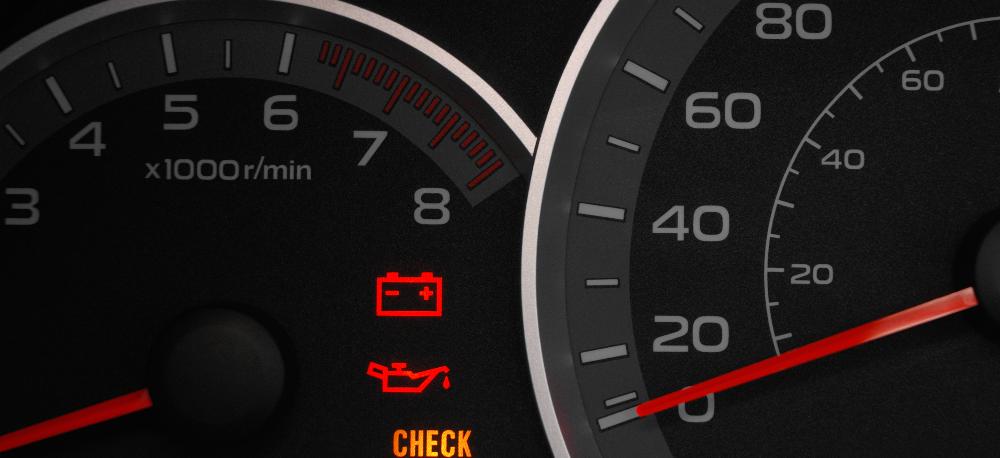
However, if the driver doesn't understand what the indicators mean, further problems may emerge. In fact, most Americans fail to understand what some of the basic car dashboard warning lights mean.
According to a survey conducted by the insurance company The Zebra, 73% of Americans don't know what the oil pressure warning light means. Additionally, the survey found that 40% of Americans risk engine failure due to a lack of knowledge regarding the coolant temperature warning light. And 30% don't know they are driving around with unsafe tire pressure.
Dashboard warning lights come in various colors. However, red lights indicate more serious issues, while yellow or amber lights may indicate a low-grade hazard. Green and blue lights alert the diver that a specific feature is activated. Keep reading to discover what the car lights symbols mean and the proper course of action if one of the symbols appears.
Warning Lights
Warning lights can appear as either red or yellow symbols. While the owner's manual will be the best source of information, it's important to understand what these symbols mean to take quick and appropriate action.
Check Engine Light

The check engine light is one of the most common and important warning symbols that may appear on your dashboard. Unfortunately, it's also one of the most ambiguous warning symbols because it may mean one of several issues. When the check engine light symbol appears, it generally indicates something is wrong with the systems that control engine functions. In certain cars, it can monitor the transmission as well.
Collision Repair EstimateRepairing All Makes & Models
While it may be difficult to pinpoint the exact issue, some of the most common reasons this symbol may appear are due to:
- Low oil pressure
- Overheating
- The gas cap is open, loose, or cracked (potentially causing fuel to evaporate)
- Misfire, knocking, or loss of compression (potentially resulting in early engine wear and tear or failure)
So, what should you do when the check engine light comes on? There's no reason to panic if the check engine light turns on while driving, but it shouldn't be ignored either. We recommend pulling the car over to check the gas cap and other systems in the vehicle. If possible, try to get the vehicle over to a mechanic to run a diagnostic test.
However, if the light is flashing, it's recommended to stop driving and call a tow truck. Generally, a flashing check engine light indicates a serious issue that may result in further damage if ignored.
Battery Warning Light

Unlike the check engine light, the battery warning light is easier to decipher. If this red battery symbol appears on the dashboard, it indicates that the vehicle's charging system is low on power or not charging properly. However, the battery warning light may also signal that the alternator belt is damaged. If the battery is the main issue, the clock may start slowly fading, or the headlights may start dimming.
Can you drive your car with the battery light on?
Sometimes the light will illuminate, but the car will turn on and run smoothly. The battery warning light is not something that should be ignored. Neglecting to address the issue may result in long-term battery issues or potential problems with the alternator.
Oil Pressure Warning Light

The oil pressure warning light indicates there's an issue with the vehicle's oil pressure system. If illuminated, the symbol may imply that the car's oil needs to be topped off. However, the oil pressure warning light may point to deeper issues. It may indicate a leak in the engine or some parts have worn out, such as a broken oil pump or a blown piston ring.
If this light appears on the dashboard, try checking the oil dipstick when possible. If the oil levels are low, adding oil may do the trick. If the symbol remains on, the issues run deeper than just needing oil. It's recommended to get this issue checked out as soon as possible. Driving around with the oil pressure warning light on may create more problems down the line.
Engine Temperature Warning Light
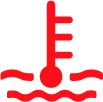
The engine temperature warning light indicates the engine is overheating. This symbol may appear on your dashboard for a variety of reasons. Some of the most common ones include:
- The coolant is too low, leaking, or old
- The radiator may be clogged with debris, or the radiator hose has collapsed
- Failure of the cooling fan
- Blown head gasket
The engine temperature warning light essentially means there is an issue with the cooling system or the coolant. If the cooling system is working properly, this symbol should not appear. Driving for extended periods while the engine temperature light is illuminated is not recommended. Doing so may quickly ruin the engine. If this light appears on the dashboard, reach out to a local mechanic to immediately resolve the problem.
Safety Symbols
Generally, safety symbols provide similar indicators as warning symbols. The majority of lights that may be concerning will appear as either red or yellow. However, certain indicators, such as the icy road warning light and clogged air filter, may appear white. This section will focus on the more common and potentially serious safety symbols.
Tire Pressure Monitoring System Indicator

At first glance, the tire pressure indicator doesn't seem too harmless. The symbol indicates the tread of a car tire. Driving around on under or overinflated tires may cause serious damage to the vehicle's tires.
Fortunately, most modern vehicles include an indicator to alert the driver of the exact tire pressure for each tire. If one tire is too low, refill the tire to the correct pressure as soon as possible. Once the car starts and the indicator doesn't go away after a few minutes, the tire may be damaged, resulting in a rapid leak.
Anti-Lock Braking System (ABS)

The anti-locking brake system (ABS) prevents the driver from applying too much pressure to the brakes. This system is implemented so the axle and the wheels don't stop turning. It's important to know that every time a vehicle turns, the car does a self-check. So, the light may appear on the dashboard for a couple of seconds. However, if the light stays on, there may be a deeper issue. Some of the most common reasons that the ABS indicator lights up include the following:
- Malfunctioning ABS module
- Fluid reservoir levels may be low
- The wheel speed sensors may be broken
- The system may be turned off
If the ABS light stays on for more than a few seconds, it's recommended to consult with a mechanic to resolve the issue immediately.
Transmission Temperature
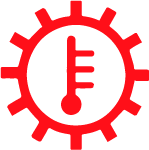
The transmission temperature light indicates that the transmission has overheated. The ideal temperature for the transmission should not exceed 200 degrees Fahrenheit. Furthermore, every additional 20 degrees over 200 may reduce the transmission's longevity by 50%.
This symbol may appear due to low transmission fluid levels and excessive wear and tear on the transmission. The transmission temperature light may appear as either red or yellow, but it should not be ignored. If the indicator illuminates while driving, it's recommended to pull over and allow the transmission to cool down. If that doesn't do the trick, taking the vehicle to a mechanic as soon as possible may help prevent further damage.
Coolant Temperature
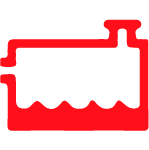
The coolant temperature light may be harder to decipher than the others mentioned on this list. Depending on the manufacturer, the symbol may appear as red, yellow, blue, or white. However, the coolant temperature symbol should look like a thermometer floating on water.
Similar to some of the other dashboard indicators, the coolant temperature will alert the driver that the car is running at excessive temperatures. This symbol may appear because there is a broken water pump, low coolant levels, a leak within the coolant hose or damage to the radiator.
The coolant temperature indicator should not be ignored, and doing so may lead to serious engine problems. Driving with the coolant temperature light illuminated is unsafe, and there's a possibility the four-wheel mode may get permanently damaged.
Lighting Symbols
Generally, lighting symbols don't alert the driver to a serious mechanical issue. These symbols let the driver know a specific lighting feature is currently activated. Lighting indicators typically appear as blue, yellow, or green.
Low Beam Indicator Light

The low beam light is intended to be used in specific circumstances. Some of those include:
- Visibility is difficult due to weather conditions
- If a road sign indicates a daytime headlight section
- Within 500 feet of another car (certain states require a driver to switch from high beams to low beams when another vehicle is approaching)
This symbol indicates the vehicle's low beams are activated.
High Beam Light Indicator

High beam light gives the driver a bright light that ranges between 350 and 400 feet. Like low beams, high beams are intended to be activated during certain situations, such as low visibility due to fog.
The high beam symbol looks like a blue rocket ship with flares coming out the back. If that symbol is on the car's dashboard, then the high beam function is activated.
Auto High Beam Light Indicator

The auto high beam indicator is built into most modern vehicles. The car will automatically turn on the high beams if the vehicle senses they are needed.
Lamp Out Indicator

The lamp-out indicator is yellow and looks like the sun. This symbol may appear on the dashboard if one or more of the vehicle's exterior lights are not functioning properly or completely out.
Additional Light Indicators
Below are some additional light symbols. None of the indicators mentioned below will require the driver to seek immediate attention. These additional light indicators are for specific features within the car.
Lane Assist

Lane assist is a fairly new feature to modern vehicles. This feature is designed to help the driver stay in the designated lane. The symbol may appear on the dashboard if the system is activated and road markings can be detected.
Blind Spot Warning Indicator

The blind-spot warning system is also new to the general population and may be an upgradeable feature for certain cars. Unlike the other indicators mentioned above, the blind-spot indicator may appear on the side-view mirrors.
This indicator will appear when a vehicle or a different obstruction appears in the driver's blind spot. Additionally, the car will alert the driver via a beep sound. However, the beep sound may only be activated when a blinker is engaged.
Low Fuel Level Indicator
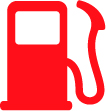
The low fuel level indicator may be one of the most common and recognizable indicators. Essentially, this indicator will alert the driver that their fuel is running low and it's time to find the nearest gas station.
Windshield Defrost Indicator
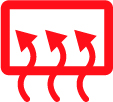
The windshield defrost indicator means the window defrost system is activated. Even in the warmest winter, the windshield defrost system is important for visibility.
Gerber Collision Is Here to Provide Assistance
Car dashboard warning lights appear to assist the driver and promote a safe driving experience for everyone on the road. If one of the serious symbols appears on the dashboard, check the owner's manual for the best advice.
While Gerber may not be able to help with every dashboard indicator, we're here to help in the event of a collision. We specialize in auto body repair, paintless dent repair, hail damage, and glass repair. Contact Gerber Collision at 1-877-743-7237 or visit our website for more information.






